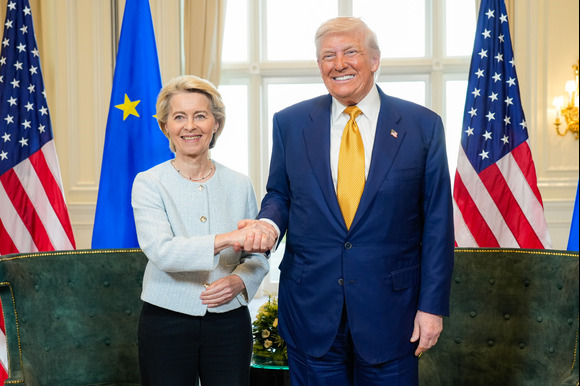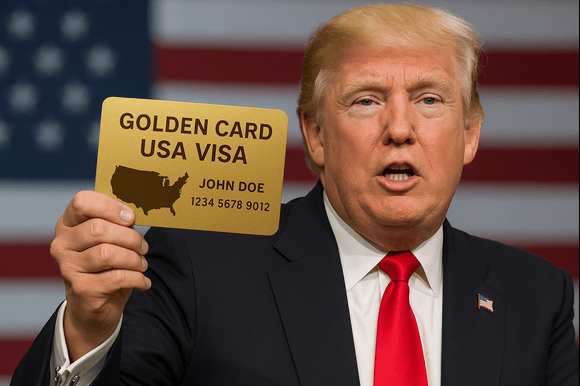
Fred Guerdin / European Union, 2025
US President Donald Trump has reversed course on plans to impose steep tariffs on pharmaceuticals and semiconductors imported from the European Union, following growing concerns from both American and European businesses.
Last month, Trump had signaled that pharmaceuticals and semiconductors were not included in the US-EU provisional trade agreement, raising the possibility that those sectors could be hit with punitive tariff rates of 250% and 100%, respectively.
However, new details released on Thursday regarding the agreement between Washington and Brussels confirm that EU pharmaceutical and semiconductor exports will instead face a maximum tariff of 15%—bringing them in line with most other sectors covered by the deal.
The EU, however, must first pass legislation to eliminate tariffs on US industrial exports to qualify for a reduction in car export tariffs—from the current 27.5% to 15%. A joint statement released by the US and EU described the arrangement as a “first step in a process” with the potential for further expansion as trade relations develop.
The trade agreement was initially unveiled at a meeting in Scotland last month between President Trump and European Commission President Ursula von der Leyen. At the time, they agreed to cut tariffs on most EU goods to 15%—half of the 30% rate originally threatened by the Trump administration, but higher than the 10% deal secured separately by the UK.
Von der Leyen characterised the pact as a “framework” agreement, with many of the technical details still to be finalised in the following weeks.
Subsequent threats from Trump to impose harsher tariffs on pharmaceutical and semiconductor imports sparked fears that these high-value sectors would be excluded from the final deal. In July, the US president had threatened a 200% tariff on pharmaceuticals, later raising the possibility of increasing it to 250% during an interview on CNBC on 5 August.
“We want pharmaceuticals made in our country,” Trump said at the time. The EU is a major supplier of pharmaceuticals to the US, with Ireland serving as a key hub. Denmark-based Novo Nordisk, the maker of Ozempic, is among the prominent European exporters to the American market.
On Thursday, Irish Deputy Prime Minister and Foreign Minister Simon Harris welcomed the revised terms, saying the inclusion of pharmaceuticals and semiconductors under the 15% rate “provides an important shield to Irish exporters that could have been subject to much larger tariffs.”
According to the joint agreement, the US will apply the 15% tariff rate on most EU exports—including semiconductors and lumber—starting 1 September.
In return, the EU has agreed to cut tariffs to zero on “all US industrial goods,” including a wide range of agricultural products such as pork, fresh fruit and vegetables, bison meat, and tree nuts.
However, the White House has made it clear that the EU must first enact legislation to remove these tariffs before the US will lower its own 27.5% tariff on EU automobile exports to 15%. EU Trade Commissioner Maros Sefcovic said at a press conference that the deal includes a provision for the lower car tariff to be applied retroactively from the start of the month when the legislative process begins.
Sefcovic stressed that the EU’s “firm intention” is to initiate that process within August, and said the US had assured him that the reduced tariff would retroactively apply from 1 August.
Sigrid de Vries, Director General of the European Automobile Manufacturers’ Association, told the BBC’s Today programme that although the agreement was welcome, the car industry remains under pressure. “We’re not out of the woods yet,” she said, noting that since April, manufacturers have been paying “millions of euros in tariffs every day.”
“The deal says we’ll go down from 27.5% to 15%, but we’re coming from a rate of 2.5%—so the impact will continue to be large,” de Vries added. She warned this could still affect vehicle prices for consumers in the US and beyond.
European Commission President Ursula von der Leyen posted on X that the trade deal provides “predictability for the bloc’s businesses and consumers,” while offering “stability in the largest trading partnership in the world.”
Meanwhile, US Secretary of Commerce Howard Lutnick praised the deal, writing on X that it “creates historic access to the vast European markets” for American producers.
The announcement comes after months of escalating rhetoric and tough negotiations. Trump first threatened in April to slap a 30% tariff on all EU exports, setting the stage for a tense standoff between two of the world’s largest trading partners.
Still, the agreement left some sectors disappointed. Both sides acknowledged that wine and spirits failed to secure exemption from tariffs. The French Wine Exporters Federation (FEVS) warned the outcome would pose “major difficulties” for the sector.
“Unfortunately, here we didn’t succeed,” Sefcovic admitted, referring to alcohol exports, though he added, “these doors are not closed forever.”
The US Distilled Spirits Council also expressed its dissatisfaction, stating that without a “permanent return to zero-for-zero tariffs on spirits,” American distillers will struggle to plan for future expansion. It warned that continued high tariffs on European spirits would “further compound the challenges facing restaurants and bars” across the US.




